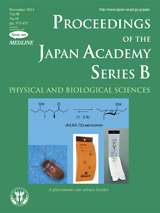About the Cover
Vol. 90 No. 10 (2014)
A sex pheromone is produced by either male or female of an organism, and attracts the same organism of opposite sex. Since 1959 when the discovery of the female-produced sex pheromone of the silkworm moth was reported, many pheromones were isolated and identified so as to clarify the chemical communication systems among organisms, hoping to utilize them as environmentally benign tools for pest managements.
The cover picture illustrates the stereostructure of serricornin, the female-produced sex pheromone of the cigarette beetle. It possesses three asymmetric carbon atoms, and therefore eight stereoisomers are possible for it. Enantioselective synthesis of the stereoisomers of serricornin revealed its (4S,6S,7S)-isomer to be the naturally occurring and bioactive isomer. Mori's studies on pheromones including serricornin by means of enantioselective synthesis contributed very much to clarify the stereochemistry of pheromone perception as summarized in his review in the present issue on pp. 373-388.
Serricornin is actually employed in pest management. Male cigarette beetles (left) can be attracted by a pheromone-baited trap (center) to be caught on a sticky material inside of the trap (right). The traps are now used in many food factories, flour mills and cigarette factories.
(4S,6S,7S)-Serricornin exists as an equilibrium mixture of the acyclic hydroxyl ketone form (left) and the cyclic hemiacetal form (right). Which is the bioactive form to be recognized by the pheromone receptor of the cigarette beetle? That is an open question.
Member of the Japan Academy




